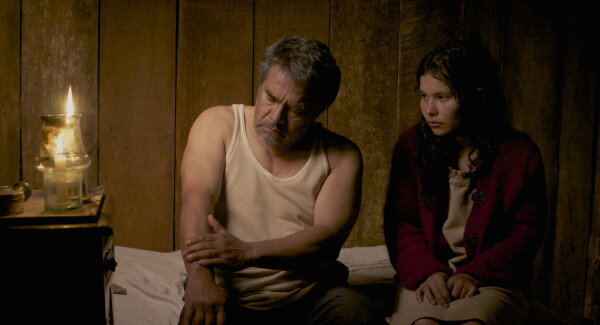The cinematography, by Sofia"..."Oggioni, gives its best in interiors, always in deep darkness, with warm candles that paint the characters in orange glimpses of light."
Almost submerged in thick black water, blinded by the hazy sky and the stinging wind that makes the trees sing like flutes. The directorial debut of William Vega reflects the location where it was filmed, the luxurious shores of a great lake in Colombia, where every step is slowed by the mud. As the characters calmly perform their daily duties, so the camera quietly follows them, focusing both on people and nature. After an astonishing and genuinely disturbing opening, we get to know Alicia (Joghis Seudin Arias), a Colombian refugee who seeks asylum at her uncle’s guest house, after her village has been destroyed. We don’t get to know anything else, and even as the film goes on, nothing is explicitly told. Nevertheless, Vega succeeds in realizing a superb movie that works on different levels, and each one is as appealing as the others.
The love for the environment in which the film takes place is made clear by the harmony between camera and nature. Many minutes are dedicated to the lake’s water that never stops moving, where fishermen, like Alicia’s uncle Oscar (Julio César Roble), are forced in a state of precarious balance, the wood that slowly rots, the imposing vegetation, both beautiful and menacing, the rain that batters on the foil roof of the house that Alicia and Flora (Floralba Achicanoy), the housekeeper, are restructuring, waiting for the tourists to come. But the tourists may never come at all. A permeating sense of apocalyptic doom, like in Bela Tarr’s movies is perceivable for the entire time, intensified by the mysteriousness of the plot. We don’t really know why Alicia’s village has been destroyed, and why everybody treats her with diffidence. It’s difficult to understand the intentions of Oscar, his face carved in pain and patience, indecipherable. He spies on Alicia through a slit in the wall, as she changes clothes in the other room, with eyes that could be of affection or lust. Every time his hand touches her body it’s difficult to understand what drives that hand. The fear of rape is a constant menace that never actually take place under our eyes. So, when Alicia seeks comfort in her uncle’s room because of the drunk guests in the other rooms, we are both scared and curious about what will happen next, but our questions won’t be answered.
What could be a major plot point in other movies is just one of the many events that Alicia has to deal with: her love for Mirichi (David Fernando Guacas), the boy who saved her with his boat, an apparently lovable character who also has his own secrets, the fear that what happened to her village can happen again, or the sudden return of Freddy (Heraldo Romero), Oscar’s son, who seems to be the only one who knows what will happen next. The movie can also be read as a political statement, on the civil guerrilla that takes place in countries such as Colombia. A situation that, despite is commonness, is too often ignored by the western eye. Obviously, the director’s choice to make a movie that gives lots of questions but few answers can’t fully satisfy a viewer that might be interest in the social and political background of the story, but the crude impact of the film, especially the first and last sequence, should spur every viewer to know more about this not so distant country.
The cinematography, by Sofia Oggioni, gives its best in interiors, always in deep darkness, with warm candles that paint the characters in orange glimpses of light. The camera, despite its slow pace, keeps alive the attention by following the characters in their daily actions and their scarce dialogues. Apparently distant like in a documentary, the camera movements explain more than words, when focusing a few seconds more than expected on a glance in the characters’ eyes, or on the movements of their hands. Lazy viewers will find this troubling, to fully participate in the movie’s alchemy its required an observant eye, even though the temptation to let the pictures hypnotize yourself is strong. All the actors were at their first experience (at least from what can be told by the movie’s IMDb page, that lacks quite a lot of informations), but each one is perfect in their role, portrayed in a raw and realistic way.
Being a first film, La Sirga is an extremely powerful experience, the result of a four years project. Vega is a wise director, with a contemplative eye that never forgets to focus also on characters and their actions. He manages to develop a great story, showing much and telling almost nothing, and despite being too cryptic on certain aspects, La Sirga is one of the best movies of 2012.



